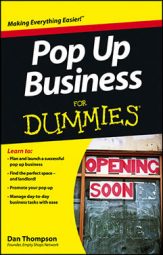Managing the risks and the health and safety requirements of a pop up largely comes down to common sense and being careful without being overly cautious.
Risk assessment isn’t static and as you now have the keys to your shop, you can carry out a more detailed assessment.
After this assessment, you need to make sure that everybody working in your pop up is briefed about the risks and how you’re managing them. You can make everyone aware through an informal induction as people come to the space for the first time – much the same as welcoming someone to your house and saying ‘mind the step as you come in’.
Keep a copy of the complete risk assessment in the shop, clearly labelled, for people to refer to if they want to. Be prepared to update it if new risks are identified.
Daily checks for risks
The risks down into three areas:
Fire safety
Health and safety
Security
Break the risks down into these three areas and use these checklists for your own risk assessment:
Fire safety checklist:
Have a phone available to make emergency calls.
Clear away rubbish and safely store other materials and resources.
Mark fire exits and clear routes of obstructions.
Test any alarms and equipment.
Have an evacuation plan in place and inform all staff and volunteers.
Health and safety:
Have a phone available to make emergency calls.
Ensure that public areas are clean, tidy and free of hazards (for example, trip hazards or stacked boxes).
Close and clearly mark areas that are off limit to the public.
Make sure that electrics and any portable electrical items are safe and visually check them for damage or broken cables.
Only let staff and volunteers use any specialised equipment.
Security:
Have a phone available to make emergency calls.
Close and lock windows and doors when the premises are not in use.
Lock and secure doors and windows in unused areas.
Offer a safe, locked area for private possessions, such as bags and coats.
Manage keys and keyholders for security
For security, you need to manage who has keys and can access your pop up. Ideally, you need two or three keyholders. Create a simple rota to decide who opens and closes the shop each day. On closing the pop up, ensure the keyholder checks that:
Nobody is left in your pop up, including in the toilet, staff room, stock room and so on.
All windows and doors are closed, locked and secured.
Fire exits are left clear.
All electrical items are safe, with equipment like kettles and coffee machines switched off.
Backstage security
Stock rooms, kitchen areas, unused spaces and toilets are all the backstage of your pop up.
The backstage areas need less management than the front-of-houses areas, the parts seen by your customers. However, they need to be tidy, safe and secure so that customers can’t wander into them by mistake.

